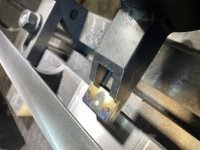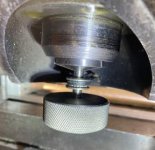Preamble (skip this if you want.): I am currently machining one of my 18's for a PM member. The inquiry raised in post 3 above will have to wait until I am machining a 36---the next week or two. I figure it may be of interest to some for me to report on the some of the methods I have learned/developed for machining one of my 18's as its unique design (And similarly the design of the 36) calls for fixturing it in ways somewhat different than used for ordinary SE's of similar length. Both could be machined nicely on a planer too, but I don't have one at my disposal and even so it would need some attention to fixturing to avoid inducing twist or warp in the casting due to clamping pressure. No doubt there are other and perhaps better methods than what I use, but I will post what I have come up with to serve as a starting point for folks who have bought raw Feathereweight 18's and to serve as a discussion starter for those with suggestions as to how to do it better. For the 18 I am using a 1 HP Bridgeport with Accu-Rite DRO and factory table feed. Overall it is quite good condition with ways in good condition and table that reasonably, but not perfectly, flat. For the 36 I am using a Lucas HBM that came out of Boeing.
Using reasonable care, I am able to get flatness of .001 in each of the two main surfaces milled and the top rail parallel within a few tenths. That seems like an acceptable job for the intended purpose---gotta leave something for the scraping hand to do, right? ;-)
I have tried making my cuts with a 3" face mill using both a right angle head which allows the cut surface to be vertical to the bed (and in theory may be preferable) and with a conventional setup. On my mill I get similar results and use the conventional setup except for facing the ends of the casting and boring fixturing holes (which can later be used for attaching handles should the user desire. I do follow the usual precautions of allowing the casting temperature to normalize prior to making final reference surface facing cuts.
I will do my best to provide a clear description of the method I use, but if what I post needs clarification, I will do my best improve it.
Now some pics:
Obviously the first step is to clean off some of the gating and flash from the casting.
![IMG_6201[2].jpg IMG_6201[2].jpg](https://www.practicalmachinist.com/forum/data/attachments/231/231428-c597ae69dced769801402753d1483c14.jpg)
Then I setup my right angle head and align it. I have milled reference flats on the side and bottom of my head to make tramming it easier.
![IMG_6202[2].jpg IMG_6202[2].jpg](https://www.practicalmachinist.com/forum/data/attachments/231/231429-605df9538e0ad3458338d124bfd25e90.jpg)
I use a simple little jig (orange in the photos) to locate a punch mark.
![IMG_6212[2].jpg IMG_6212[2].jpg](https://www.practicalmachinist.com/forum/data/attachments/231/231430-5bee535a32133da07d46a90c259d23eb.jpg)
![IMG_6215[1].jpg IMG_6215[1].jpg](https://www.practicalmachinist.com/forum/data/attachments/231/231431-21f3ce30400a0d4c2d39acd9d4f6c25b.jpg)
![IMG_6216[2].jpg IMG_6216[2].jpg](https://www.practicalmachinist.com/forum/data/attachments/231/231432-5f70e103f0de1ac709a54201212174ab.jpg)
That's the limit of five images per post. Sorry, I know this is pretty basic stuff in this post. But if I don't go step-by-step, there may be questions.
Denis


 I love it!
I love it! ![IMG_6201[2].jpg IMG_6201[2].jpg](https://www.practicalmachinist.com/forum/data/attachments/231/231428-c597ae69dced769801402753d1483c14.jpg)
![IMG_6202[2].jpg IMG_6202[2].jpg](https://www.practicalmachinist.com/forum/data/attachments/231/231429-605df9538e0ad3458338d124bfd25e90.jpg)
![IMG_6212[2].jpg IMG_6212[2].jpg](https://www.practicalmachinist.com/forum/data/attachments/231/231430-5bee535a32133da07d46a90c259d23eb.jpg)
![IMG_6215[1].jpg IMG_6215[1].jpg](https://www.practicalmachinist.com/forum/data/attachments/231/231431-21f3ce30400a0d4c2d39acd9d4f6c25b.jpg)
![IMG_6216[2].jpg IMG_6216[2].jpg](https://www.practicalmachinist.com/forum/data/attachments/231/231432-5f70e103f0de1ac709a54201212174ab.jpg)
![IMG_6217[2].jpg IMG_6217[2].jpg](https://www.practicalmachinist.com/forum/data/attachments/231/231435-fc4bf2d5a85aab95936d5ff69eb45a62.jpg)
![IMG_6203[5].jpg IMG_6203[5].jpg](https://www.practicalmachinist.com/forum/data/attachments/231/231433-6ccbf6b4f57145ba2444c42110409b5b.jpg)
![IMG_6218[3].jpg IMG_6218[3].jpg](https://www.practicalmachinist.com/forum/data/attachments/231/231434-f809146fa29d3e970918f5c3264fe830.jpg)
![IMG_6204[2].jpg IMG_6204[2].jpg](https://www.practicalmachinist.com/forum/data/attachments/231/231436-a65382d881d8509e66ae1206fbe9c69b.jpg)
![IMG_6220[1].jpg IMG_6220[1].jpg](https://www.practicalmachinist.com/forum/data/attachments/231/231437-e2755746d8b4113ec9b7c77bb3d2226f.jpg)
![IMG_6220[1].jpg IMG_6220[1].jpg](https://www.practicalmachinist.com/forum/data/attachments/231/231438-9f83407d0803f934ea5101a28f213dd6.jpg)






![IMG_6243[2].jpg IMG_6243[2].jpg](https://www.practicalmachinist.com/forum/data/attachments/231/231537-49bdb640c0ad07aa00876ddb40328866.jpg)
![IMG_6245[1].jpg IMG_6245[1].jpg](https://www.practicalmachinist.com/forum/data/attachments/231/231538-ce82ad29313de0596c7572f19e7f902c.jpg)
![IMG_6246[1].jpg IMG_6246[1].jpg](https://www.practicalmachinist.com/forum/data/attachments/231/231539-f4c7d69fee8e157c60febb0fa49bdae1.jpg)
![IMG_6247[1].jpg IMG_6247[1].jpg](https://www.practicalmachinist.com/forum/data/attachments/231/231540-47219a7897e7f6f3f540866d8b30674e.jpg)